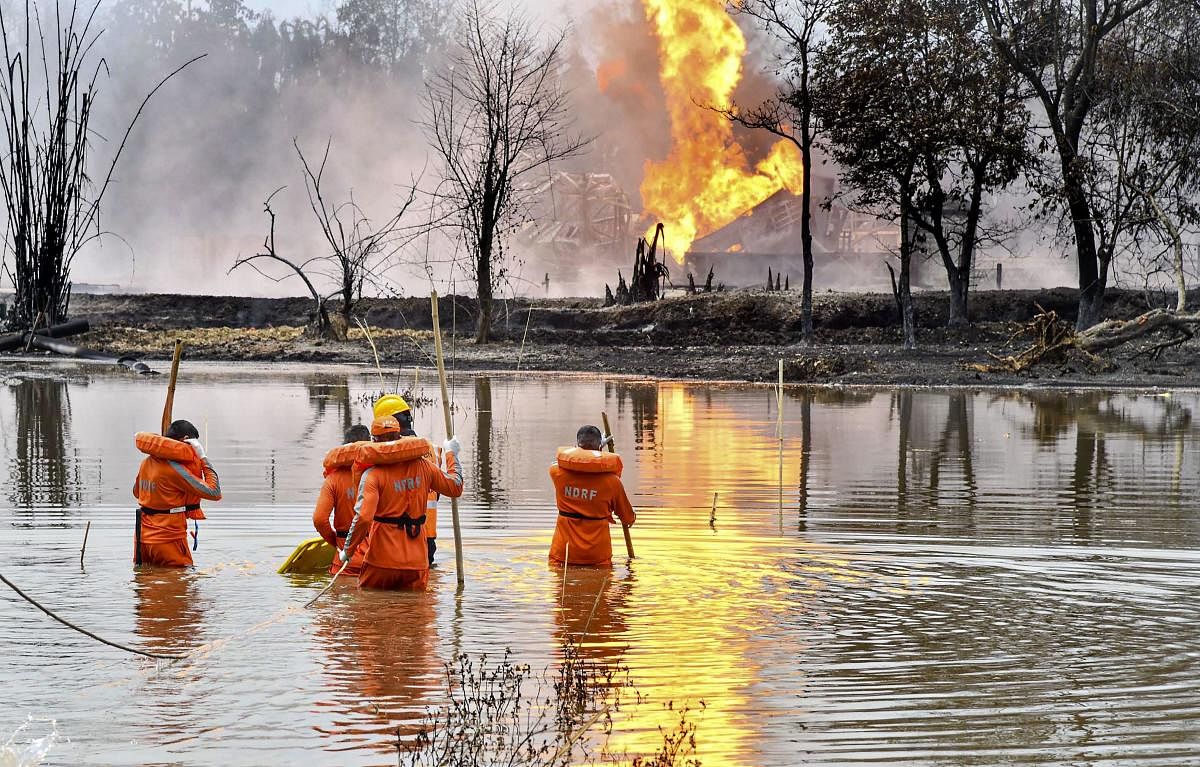
The raging fire at an oil well in Assam's Tinsukia district has caused irreversible damage to the Dibru-Saikhowa National Park and the Maguri Motapung wetland area besides jeopardising livelihood of people dependent on the land, conservationists said on Friday.
The blowout at the Oil India Ltd well occurred on May 27, which has been spewing gas "uncontrollably" for nearly two weeks, and a massive fire engulfed the site, following an explosion at the well on June 9.
The spewing of gas from the well and the subsequent fire have forced people to leave their homes.
The damage to the biosphere reserve, Dibru-Saikhowa National Park, and the Maguri-Motapung wetland was immense and perhaps irreparable, Tinsukia-based environmentalist Ranjan Das told PTI.
More than 1,500 families from nearby areas have been evacuated, rendering nearly 7,000 people homeless, while their paddy fields were destroyed and it is unlikely that the affected-land would be cultivable again, he said.
Most villagers in the area are small tea growers and their gardens have been completely damaged, the expert said.
"We have not been able to assess the damage in real terms as the fire is still raging on and the authorities are not letting us go near the affected areas. People have, however, reached out to us with stories of irreparable damages," Das said.
The blaze at the well was so massive that it was seen from a distance of more than 30 kilometres with thick black smoke going up several metres high.
The fire that killed two persons is still raging on, while the state-owned company was rushing experts from Singapore to bring the situation under control.
The spewing of gas and the subsequent fire with the pollutants releasing from the smoke will have lasting health hazards and come to the fore in days to come, Das said.
The wells at Baghjan are close to the Dibru-Saikhowa National Park and Maguri-Motapung wetland and the damage caused to both is a "matter of great concern", said Bibhab Talukdar, secretary-general of Aaranyak, an environmental organisation.
"The unabated fire, which spread horizontally, has made a severe impact on human habitation, agricultural fields, wildlife and wetland. We urge the OIL and the government agencies to act immediately to control the fire for the well-being of the local people and to save the environment," he said.
Talukdar, however, expressed doubt about the capability of the PSU to stop such a fire, saying they have "failed miserably" to prevent leaking of gas.
"It is time for the government to be more cautious and have a full understanding of the capabilities of user agencies before granting them permission in the greater interest of safeguarding people and properties from such mishaps," he said.
Wildlife biologist Udayan Borthakur said the damage that has already been caused to property, livelihood, security and ecology within the eco-sensitive zone of the national park is "irreversible".
"Any monetary compensation cannot bring back the lost biodiversity of Dibru-Saikhowa and Maguri wetland," he said.
Another matter of concern is that few days before the Baghjan well explosion took place, the PSU had received environmental clearances from the Centre for extension of drilling and testing of hydrocarbons at seven more locations under Dibru-Saikhowa National Park Area.
"Some of these locations are less than a kilometre away from the boundary of the national park," he said.
Dibru-Saikhowa National Park has a core area of 340 sq-km, while the biosphere reserve spreads across an area of 765 sq-km.
The park has a variety of tree species ranging from deciduous, semi-evergreen, wet evergreen, salix swamp to riverine grasslands.
There are at least 36 mammal species including Royal Bengal tiger, sloth bear, Chinese pangolin, Asian elephants, Asian water buffalo and feral horses in the national park, he said, adding that presence of more than 440 bird species has been reported.
Maguri, a large wetland, is an Important Bird Area (IBA) with the presence of nearly 300 species, said Borthakur who is also chief editor of the econNE, a conservation magazine of the northeast region.
"Now the question is whether Oil India will continue with its drilling extension project in Dibru-Saikhowa area, particularly after the Baghjan incident or not. Will the authorities allow them to continue without a thorough investigation into the adherence of precautionary standards," he asked.